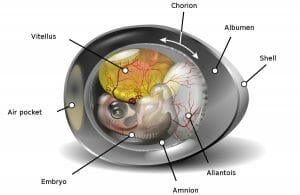Amnion Definition
The amnion is an extraembryonic membrane that surrounds a developing amniote embryo. It acts as a protective sac along with three other extraembryonic membranes: the chorion, the yolk sac, and the allantois. The membranes are then enclosed further by a shell (in birds, reptiles, and some mammals) or in a uterus (in most mammals). All four membranes protect the developing embryo through the provision of gas exchange, nutrient delivery, and waste excretion.
Amniotes
The amnion is a defining characteristic of amniotes, a group of animals that includes reptiles, birds, and mammals. Amniotes are believed to have separated from non-amniotic tetrapods about 300 – 350 million years ago. Amniotes are tetrapods that have evolved adaptations to live on land; vertebrate embryos require an aquatic environment in order to develop, and the amniotic egg provides this environment. Amniotes have also developed a number of other adaptations that allowed them to move away from the water and exploit a larger terrestrial environment.
Amnion Structure
The amnion is an extraembryonic membrane that surrounds an amniote embryo. The membrane is not part of the embryo itself, but derives from tissues that emerged from the embryo. The amnion is made from two germ layers: the mesoderm and the ectoderm. The ectoderm forms the inner portion of the amnion, and a thin mesoderm layer connects the amnion to the chorion.
Amnion Function
The amnion, along with the chorion, yolk sac, and allantois, form a series of protective barriers that provide a life-support system for the developing embryo. The four membranes work to exchange oxygen and carbon dioxide between the embryo and the placenta, to provide nutrients to the embryo, and to remove nitrogenous wastes from the embryo.
The amnion forms a sac filled with amniotic fluid. The amniotic fluid acts as a buffer to protect the embryo from physical damage due to mechanical shock. The amniotic fluid also helps to prevent dehydration and desiccation by bathing the embryo. The amniotic fluid is released at birth when the amnion breaks. In humans, this is the phenomenon known as the mother’s “waters” breaking.

This figure depicts a chicken egg. It shows the four extraembryonic membranes surrounding the embryo: the amnion, the chorion, the allantois, and the yolk sac (or vitellus).
Quiz
1. What is the main role of the amnion?
A. gas exchange
B. nutrient supply
C. waste removal
D. physical protection
2. Which tissue layer does not contribute to the amnion?
A. ectoderm
B. endoderm
C. mesoderm
D. none – they all contribute
3. What group of organisms does not have an amnion?
A. amphibians
B. reptiles
C. birds
D. mammals
References
- Campbell, N. A., & Reece, J. B. (2005).Biology, 7th. ed. Chs. 34 and 47. San Francisco, CA: Benjamin Cummings. ISBN: 0-8053-7171-0.
- Jessell, T., Lawrence, P., Meyerowitz, E., Robertson, E., & Smith, J. (2005).Principles of Development, 3rd. ed. Ch. 3. New York, NY: Oxford University Press. ISBN: 0-19-927537-8.
Amnion
No comments:
Post a Comment